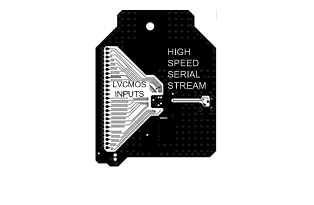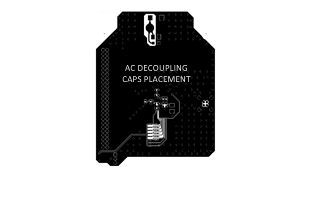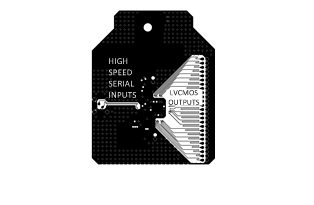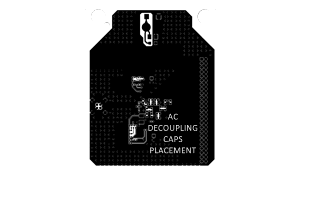SNLS231O September 2006 – April 2015 DS90UR124-Q1 , DS90UR241-Q1
PRODUCTION DATA.
- 1 Features
- 2 Applications
- 3 Description
- 4 Revision History
- 5 Description (continued)
- 6 Pin Configuration and Functions
- 7 Specifications
-
8 Detailed Description
- 8.1 Overview
- 8.2 Functional Block Diagram
- 8.3 Feature Description
- 8.4 Device Functional Modes
- 9 Application and Implementation
- 10Power Supply Recommendations
- 11Layout
- 12Device and Documentation Support
- 13Mechanical, Packaging, and Orderable Information
11 Layout
11.1 Layout Guidelines
11.1.1 PCB Layout and Power System Considerations
Circuit board layout and stack-up for the LVDS SERDES devices should be designed to provide low-noise power feed to the device. Good layout practice will also separate high-frequency or high-level inputs and outputs to minimize unwanted stray noise pickup, feedback and interference. Power system performance may be greatly improved by using thin dielectrics (2 to 4 mils) for power / ground sandwiches. This arrangement provides plane capacitance for the PCB power system with low-inductance parasitics, which has proven especially effective at high frequencies, and makes the value and placement of external bypass capacitors less critical. External bypass capacitors should include both RF ceramic and tantalum electrolytic types. RF capacitors may use values in the range of 0.01 μF to 0.1 μF. Tantalum capacitors may be in the range of 2.2 μF to 10 μF. Voltage rating of the tantalum capacitors should be at least 5× the power supply voltage being used.
Surface-mount capacitors are recommended due to their smaller parasitics. When using multiple capacitors per supply pin, locate the smaller value closer to the pin. A large bulk capacitor is recommend at the point of power entry. This is typically in the 50-uF to 100-uF range and will smooth low frequency switching noise. TI recommends connecting power and ground pins directly to the power and ground planes with bypass capacitors connected to the plane with via on both ends of the capacitor. Connecting power or ground pins to an external bypass capacitor will increase the inductance of the path.
A small body size X7R chip capacitor, such as 0603, is recommended for external bypass. Its small body size reduces the parasitic inductance of the capacitor. The user must pay attention to the resonance frequency of these external bypass capacitors, usually in the range of 20 MHz to 30 MHz. To provide effective bypassing, multiple capacitors are often used to achieve low impedance between the supply rails over the frequency of interest. At high frequency, it is also a common practice to use two vias from power and ground pins to the planes, reducing the impedance at high frequency.
Some devices provide separate power and ground pins for different portions of the circuit. This is done to isolate switching noise effects between different sections of the circuit. Separate planes on the PCB are typically not required. Pin description tables typically provide guidance on which circuit blocks are connected to which power pin pairs. In some cases, an external filter many be used to provide clean power to sensitive circuits such as PLLs.
Use at least a 4-layer board with a power and ground plane. Locate LVCMOS signals away from the LVDS lines to prevent coupling from the LVCMOS lines to the LVDS lines. Closely coupled differential lines of 100 Ω are typically recommended for LVDS interconnect. The closely coupled lines help to ensure that coupled noise will appear as common-mode and thus is rejected by the receivers. The tightly coupled lines will also radiate less.
Termination of the LVDS interconnect is required. For point-to-point applications, termination should be located at both ends of the devices. Nominal value is 100 Ω to match the differential impedance of the line. Place the resistor as close to the transmitter DOUT± outputs and receiver RIN± inputs as possible to minimize the resulting stub between the termination resistor and device.
11.1.2 LVDS Interconnect Guidelines
See AN-1108 (SNLA008) and AN-905 (SNLA035) for full details.
- Use 100-Ω coupled differential pairs
- Use the S/2S/3S rule in spacings
- S = space between the pair
- 2S = space between pairs
- 3S = space to LVCMOS signal
- Minimize the number of vias
- Use differential connectors when operating above 500-Mbps line speed
- Maintain balance of the traces
- Minimize skew within the pair
- Terminate as close to the TX outputs and RX inputs as possible
Additional general guidance can be found in the LVDS Owner’s Manual (SNLA187) - available in PDF format from the TI web site at: www.ti.com/lvds
 Figure 29. AC-Coupled Application
Figure 29. AC-Coupled Application

 Figure 31. Receiver Termination Option 2
Figure 31. Receiver Termination Option 2
 Figure 32. Receiver Termination Option 3
Figure 32. Receiver Termination Option 3
11.2 Layout Examples
 Figure 33. Example DS90UR241-Q1 EMC Layout
Figure 33. Example DS90UR241-Q1 EMC Layout
 Figure 34. DS90UR241-Q1 EMC EVM Layer 4
Figure 34. DS90UR241-Q1 EMC EVM Layer 4
 Figure 35. Example DS90UR124-Q1 EMC Layout
Figure 35. Example DS90UR124-Q1 EMC Layout
 Figure 36. DS90UR124-Q1 EMC EVM Layer 4
Figure 36. DS90UR124-Q1 EMC EVM Layer 4